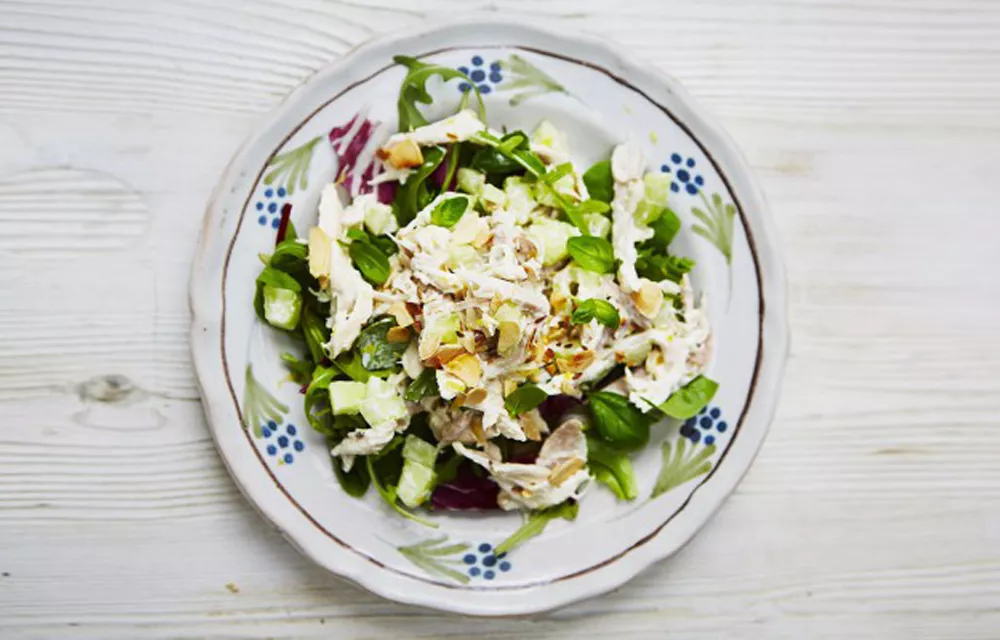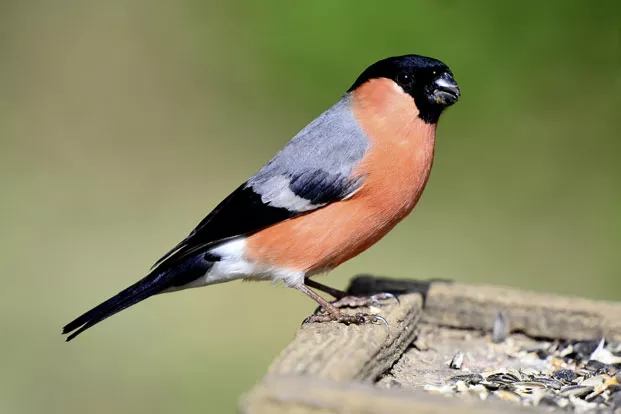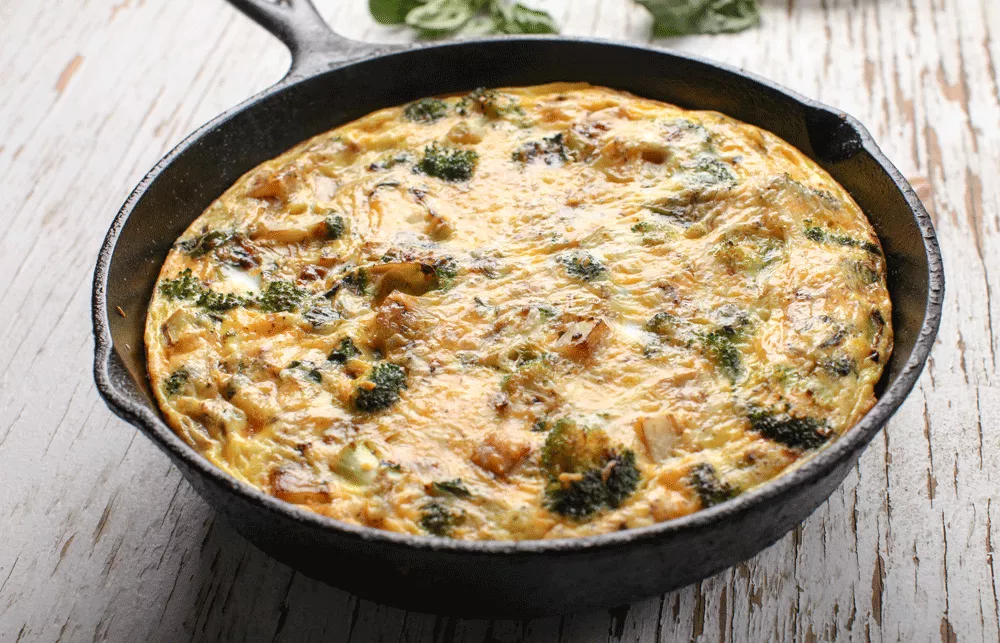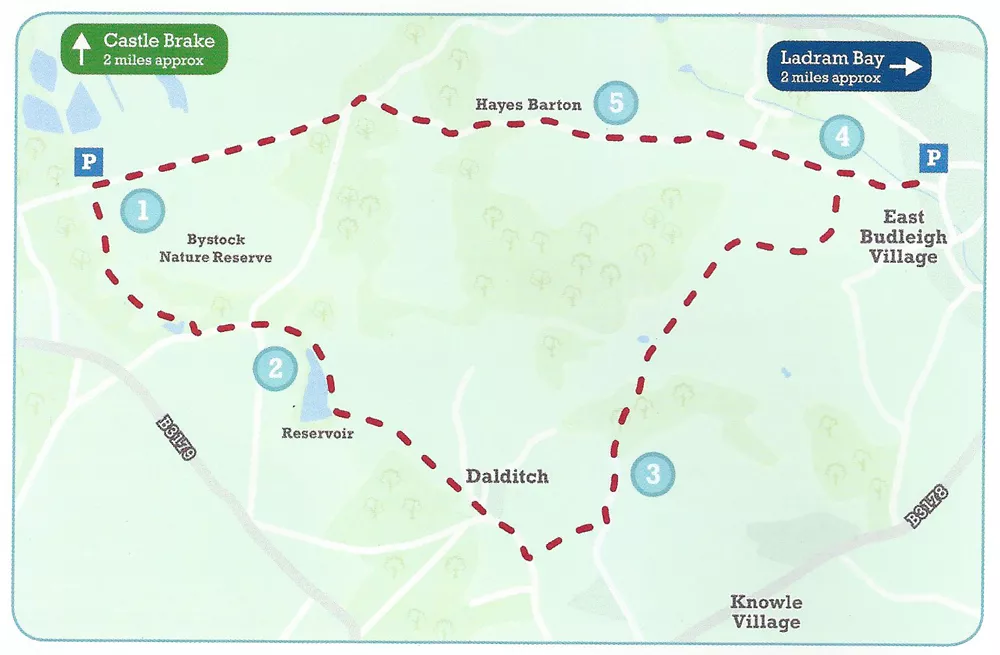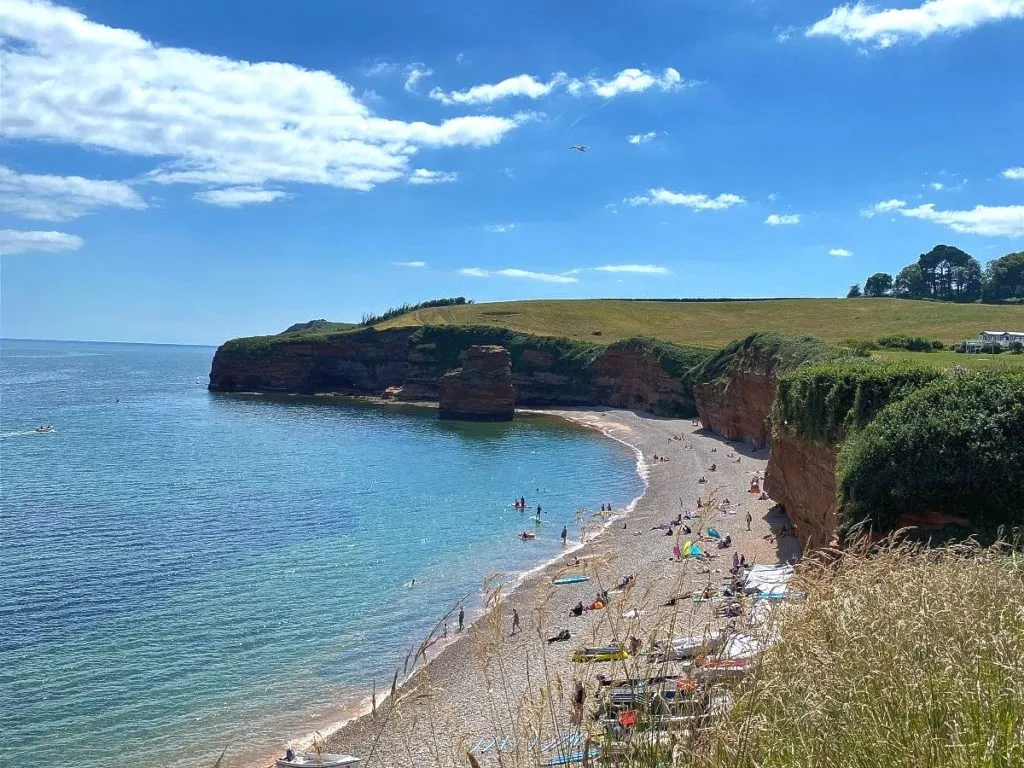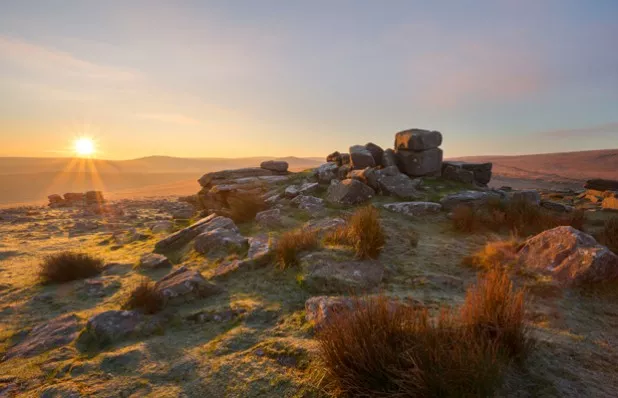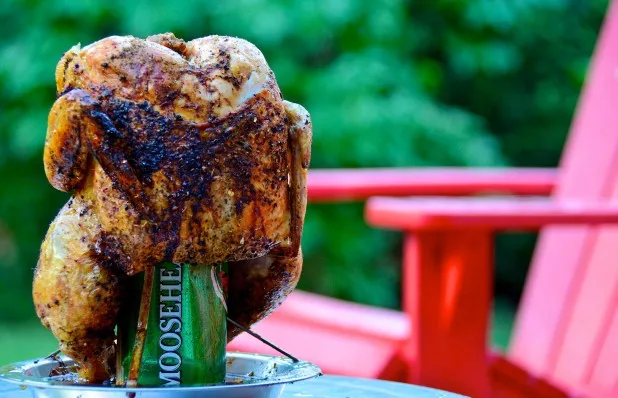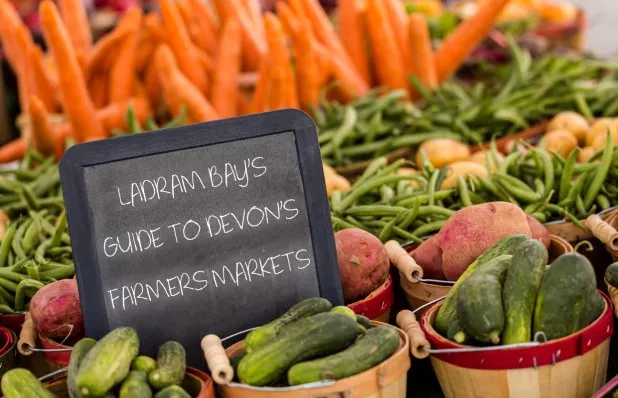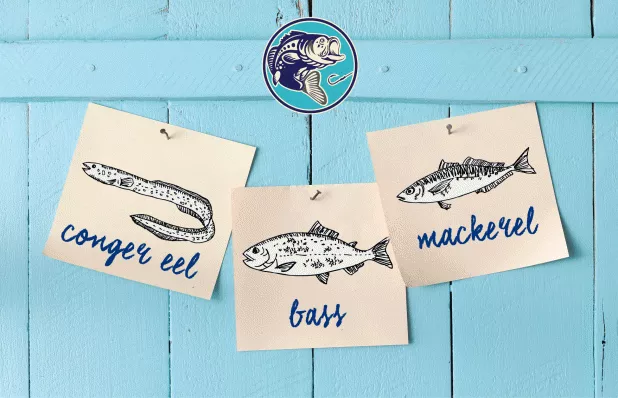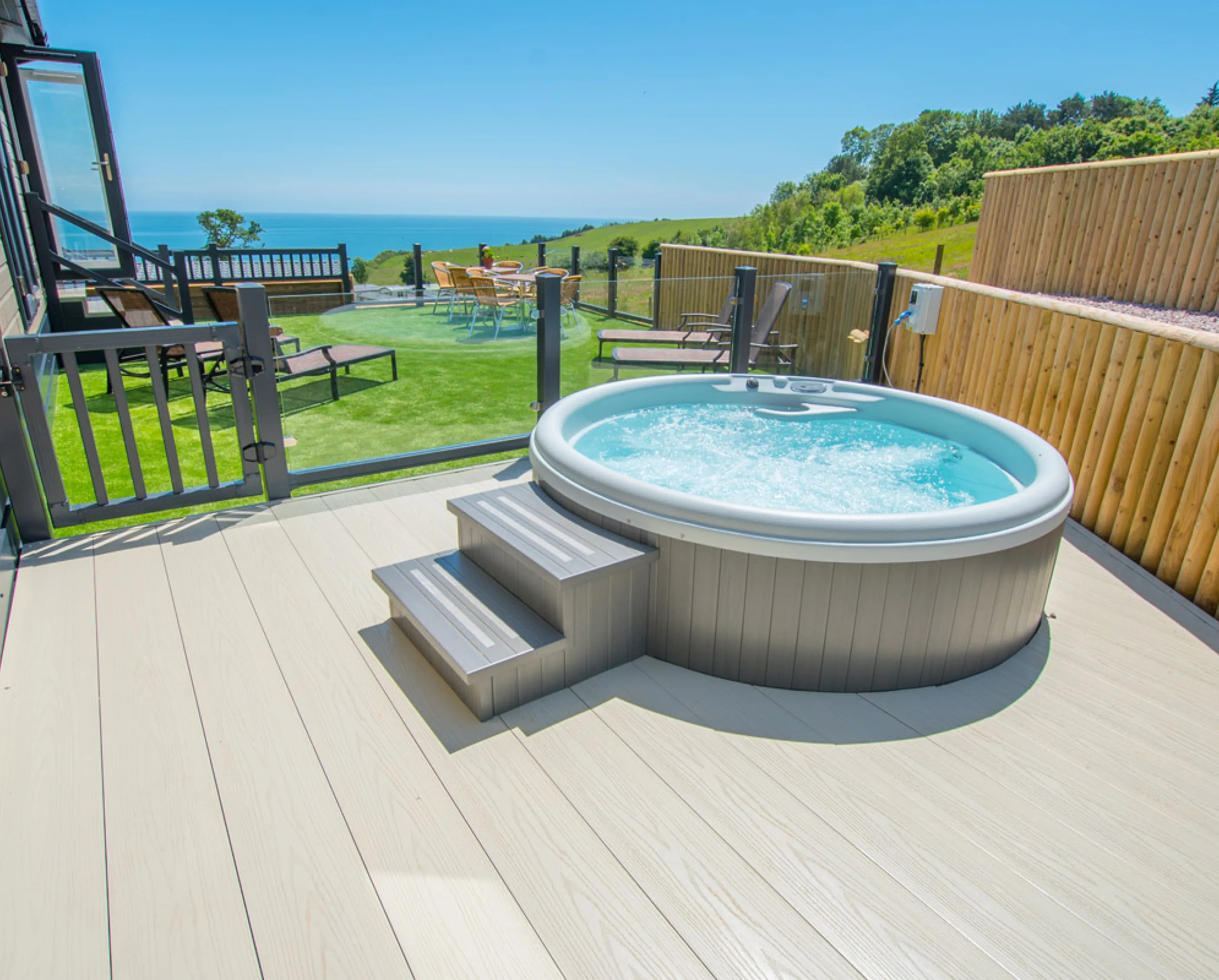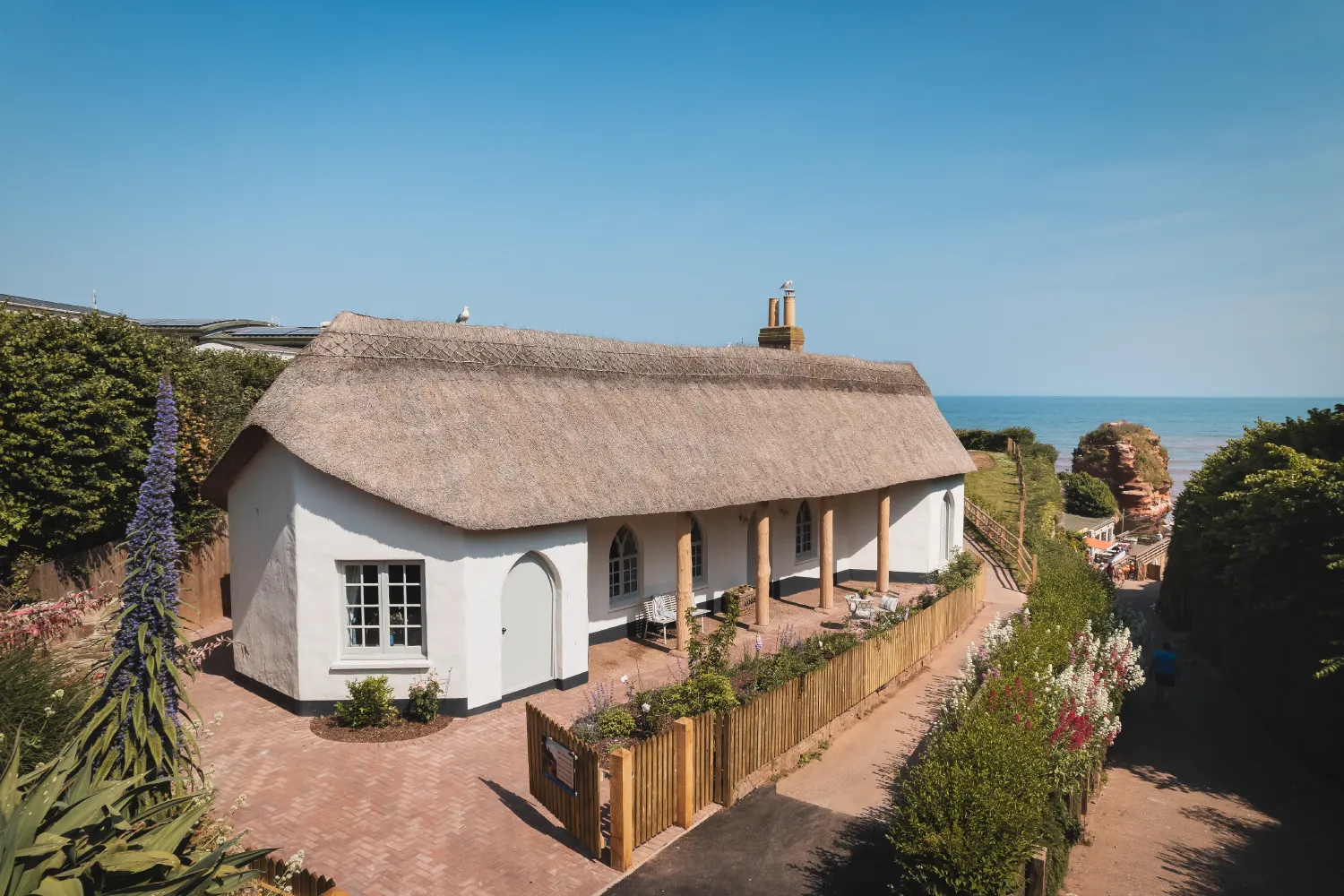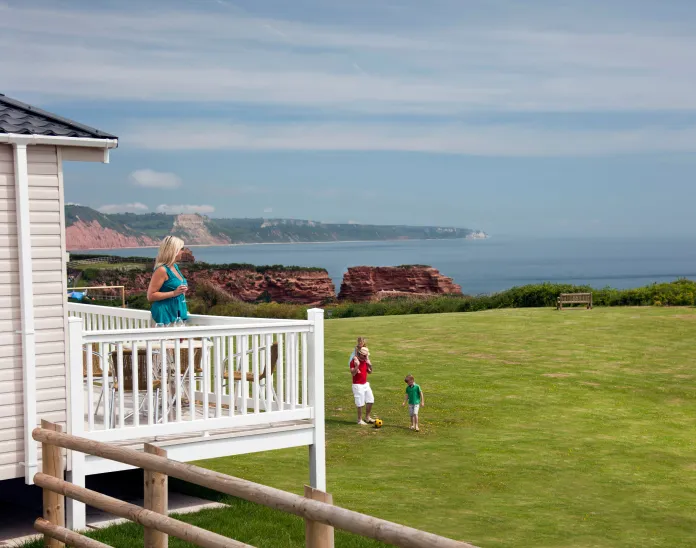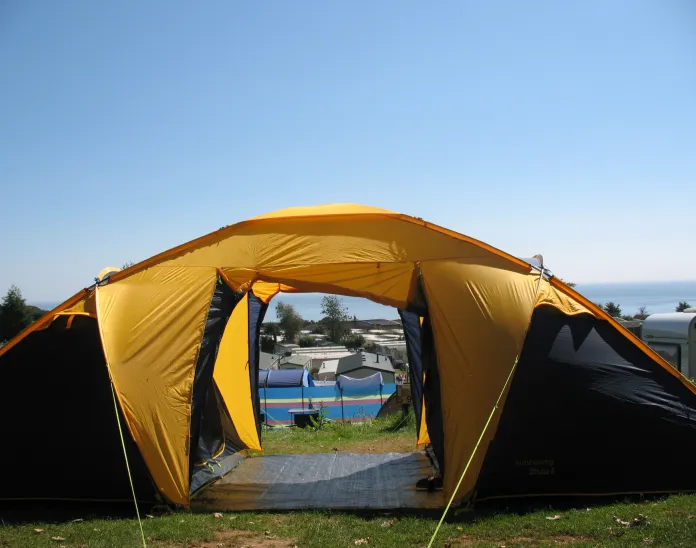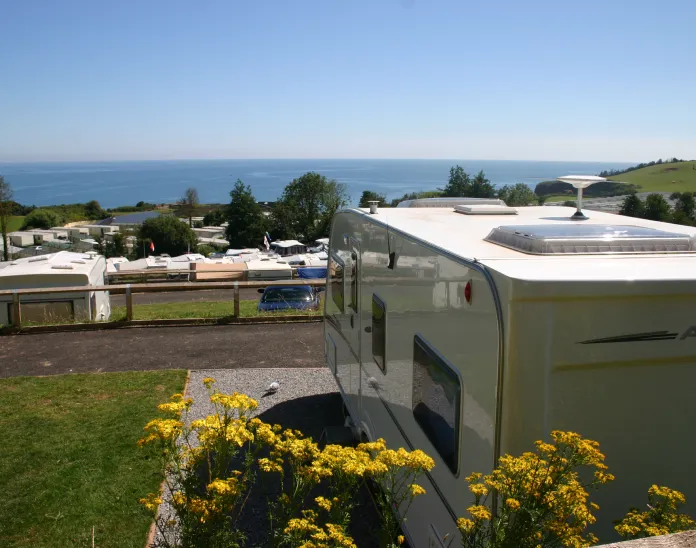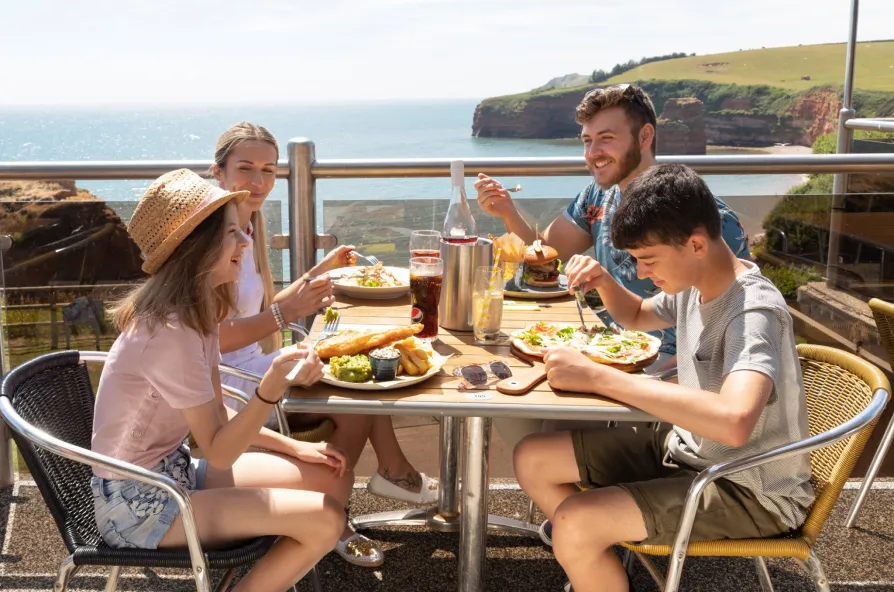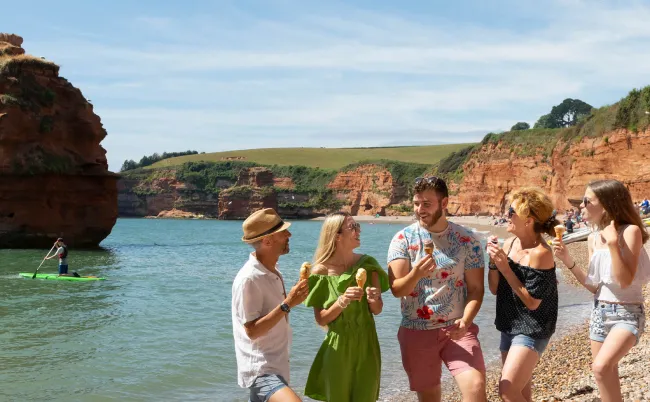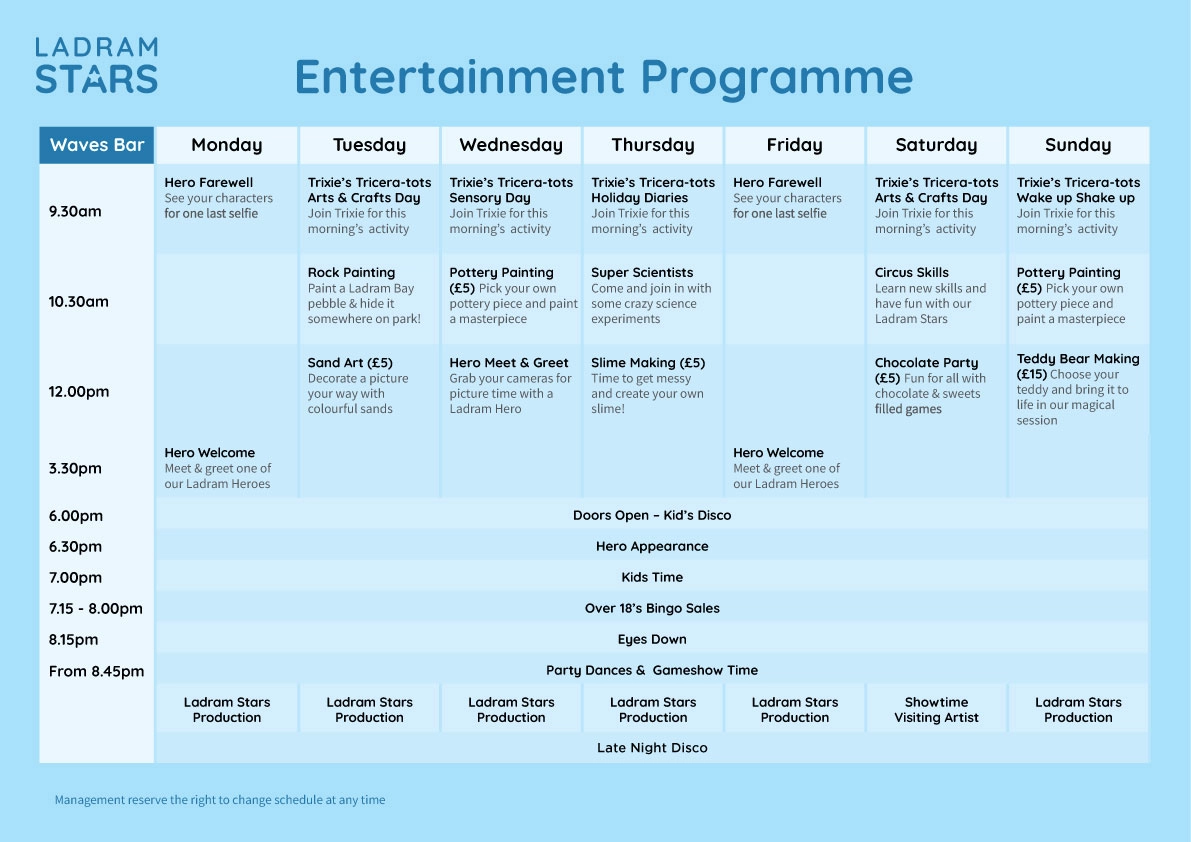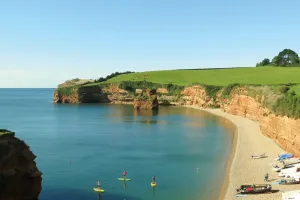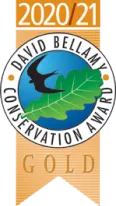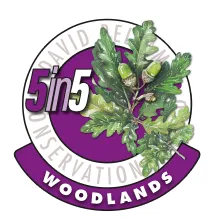Ever fancied working in the holiday industry? If so then have you considered joining the Ladram Bay team.
Every year we look for hardworking, responsible and trustworthy people who are motivated and most importantly can welcome and relate to our customers.
Working at Ladram Bay provides a family atmosphere set in a stunning location and you will receive a range of career options, training and brilliant people to work with. It’s great fun, but also hard work and is certainly not your standard nine-to-five – challenges can arise at any point during any given season.
If your application is successful, you’ll be contacted and invited to an interview with a department manager. Don’t forget your CV!
We look out for candidates with strong customer service skills, a willingness to learn and a positive ‘can do’ attitude. Some of our positions will require experience or qualifications such as our Lifeguarding roles. Be sure to inform us of your previous experience and transferable skills.
Every day is a different day at Ladram Bay and you never know what to expect in this beautiful corner of East Devon.
For online applications please email your CV & covering letter to info@ladrambay.co.uk.
Seasonal, Temporary and Permanent positions in a wide range of departments.
Potential for additional overtime within our Housekeeping Department.
Work in a stunning location
Staff discount scheme* (*after probation period)
Competitive salaries offered
Holidays are typically when we indulge ourselves with seconds or that extra ice cream – our latest holiday cooking guide is a healthy and super simple chicken salad recipe with a nutty yogurt and cucumber dressing.
Easy Chicken Salad Recipe
Easy to make
40 mins cook time
Serves 4 people
Gluten-free
Ingredients for the chicken
1.2kg of chicken thighs or breast
Black pepper
2 teaspoons of cumin seeds
Several almonds
A bay leaf
Ingredients for the dressing
3 tablespoons of low fat mayo
2 tablespoons of natural yogurt
2 lemons (zest & juice)
1 cucumber (peeled & chopped)
Pinch of fresh basil
Ingredients to serve
4 large handfuls of salad leaves
Preparation Instructions
Boil a large pan of water and place the chicken, peppercorns and bay leaves in and simmer for around 40 minutes. After 40 mins take the chicken out, remove the skin and shred the meat. Now dry-fry the almonds and cumin in a separate small pan – leave both pans to cool.
To make the dressing simply mix the yogurt, mayonnaise and lemon (zest & juice) together along with the chicken, cucumber, cumin and almonds. Lastly add in the basil and place each portion on a bed of salad.
Ladram Bay Supermarket
By now you’re probably wanting to try this recipe for yourself? For those staying with us you’ll be able to find all the ingredients used in this recipe at the Ladram Bay Supermarket. Your chicken will come from Greendale Farm just 8 miles away from Ladram Bay.
Easy Chicken Salad Recipe
Our latest guide looks at birds to look out for in Devon throughout the year and the ideal locations to find them.
Many of these can be seen at Ladram Bay and the surrounding areas, you can even lend a hand by keeping little bundles of twigs and dry moss around your holiday homes for them to use as nesting material.
Bird Identifier
The RSPB have put together this really useful bird identifier to help you confirm your sightings.
During spring, Sparrows (pictured below), Blackbirds, Robins and other garden birds will be gathering and carrying twigs, moss and feathers in their beaks as they start to build their nests.
You may hear (or spot) tiny warblers such as Chiffchaffs as they return to the UK after a warm winter in Africa. In mid-spring, Finches and other farmland birds often visit gardens seeking extra food. Towards the end of the season you may spot Bullfinches (pictured) lured into gardens by buds on fruit trees.
Between May and September, those living near woodlands are often treated to a display of spotted flycatchers, which perch in trees and then surge upwards to catch insects in flight.
Devon’s diverse landscape includes marshlands, moors, commons, forest and fields, making it a haven for our winged little friends. For those twitchers itching to find the best bird watching spots in Devon, we’ve put together a list of prime bird watching locations near to Ladram Bay.
Woodbury Common
Part of the East Devon Pebblebed Heaths, the wider area also includes Bicton Common, Dalditch Common, East Budleigh Common, Colaton Raleigh Common, Mutters Moor, Hawkerland, Harpford Common and Aylesbeare Common.
The sites have been designated a Special Area of Conservation, a Site of Special Scientific Interest and a Special Protection Area. In short the area is considered one of the most important conservation sites in Europe and is also a great place to go dog walking in East Devon.
The Pebblebed heaths offer a safe haven for wildlife and a great location to view many rarer species. To date a total of 140 bird species have been spotted on the heaths, of which 66 are known to breed regularly.
Of these regular breeders, 28 birds are of conservation concern, these include the Dartford warble (pictured below), the Hobby and the Nightjar, the latter of whom migrate to the common all the way from Africa each year.
Look out for:
Dartford warbler (pictured)
Hobby
Nightjar
Address:
See Google Maps for coordinates
Bowling Green Marsh – Topsham
Bowling Green Marsh is located on the East Devon side of the Exe Estuary just outside the picturesque town of Topsham (walking distance). The site is an important site for wintering birds and considered by the twitching community as one of the top places to watch birds in south-west.
Would be twitchers can see a wide range of waterbirds at very close range in winter, including hundreds of black-tailed godwits and wigeons as they feed close to the hide. Throughout the year, the open water attracts many different species of wetland birds; little grebes, mute swans and a variety of ducks breed here.
As there isn’t a car park onsite (except for Blue badge holders), please follow our directions which will take you to the Holman Way car park (click link for Google Maps).
Look out for:
Lapwings (pictured)
Redshanks
Listen for rare Cetti’s warblers
Address:
See Google Maps for coordinates
Dawlish Warren Natural Reserve
The Dawlish Warren Nature Reserve is located on the west side of the Exe Estuary (adjacent to Bowling Green Marsh in Topsham in East Devon) in an area of grassland, mudflats and sand dunes. The reserve centres on a 1.5 mile long beach at the mouth of the Exe Estuary.
Being part of the the Exe Estuary, Dawlish Warren Nature Reserve is an extremely important place for wildfowl and wading birds in the UK with thousands of birds visiting to feed, migrate, or spend the winter.
Each autumn up to 23,000 wildfowl and other wading birds travel to the Exe Estuary from the north to escape the cold, they typically start arriving in August and stay until late March / early April.
Dawlish Warren is also vital for roosting (and resting) for birds on high tides. During high tides (about 3 hours before and after), thousands of birds gather on the Warren’s shores. These usually include flocks of Dunlin, Grey Plover (pictured above), Bar Tailed Godwit and Oystercatcher. Brent Geese and Wigeon, while Teal also shelter further inshore.
Address:
See Google Maps for coordinates
Seaton Marshes LNR
Colyford Common and Black Hole Marsh Local Nature Reserves, collectively know as the Seaton Marshes attract considerable wildlife including Wading and Wildfowl birds in the winter. The paths that run through the reserve are very accessible, making it perfect for a younger and older twitchers alike. The 360-degree viewing hide provides fantastic views of the nature reserve and the Axe Estuary.
The marshes teem with bird life in the winter, with some rare visitors using the area as a stop over as well as large feeding flocks of Teal, Shelduck and Wigeon. On colder days visitors may even be lucky enough to spot the elusive Snipe, while Black tailed Godwit can be seen feeding amongst larger numbers of Shoveler and Curlew (pictured below). The flocks of Curlew are often seen feeding on the mud flats as they use their long specially adapted downward curving beaks to scour the ground, used for pulling up food (like lugworms) that hide deep down in the mud.
The summer sees many breeding birds return to the marshes, notably Kingfishers, which are often seen fishing from a perch directly in front of the hide. The reserves bird hide and feeding table allows twitchers to get close-up views of birds that wouldn’t normally visit your garden, such as Reed Buntings and even Water Rail.
Look out for:
Curlew (pictured)
Teal
Shelduck
Wigeon
Shoveler
Kingfishers
Buntings
Water Rail
Address:
Harbour Road, Seaton, Devon, EX12 2LX, this can be reached with a short walk from the Harbour Road car park.
For our first holiday cooking guide of 2016 we thought we would keep it simple, healthy and most importantly shareable.
The latest instalment in our series of holiday cooking guides is all of these, think of it as the thinking man’s omelette with an Italian twist.
Easy Frittata Recipe
Easy to make
20 mins prep time
Serves 4 people
40 mins cook time
Ingredients Required
1/2 teaspoon of olive oil
1 leek or a bunch of spring onion
85g of macaroni or fusilli
85g of sweetcorn
85g of frozen peas
1 red pepper (deseeded)
2-3 eggs (depending on size)
150ml of semi-skimmed milk
1 tablespoon of thyme
50g of cheddar cheese
2 tablespoons of grated parmesan
Cooking Tips
To ensure your frittata is fluffy, beat and salt the eggs JUST prior to cooking. If you mix the eggs and the salt before you start cooking and allow them to sit around the eggs will be watery (not good).
Use a timer because there is nothing worse than an undercooked (runny) or overcooked (rubbery) frittata.
Preparation Instructions
Turn your oven on and let it heat up fully before using it, this will minimise the chance of undercooking.
Turn the oven up to 190 (fan) or 170 (gas).
Grease your baking dish with olive oil.
Bring a large pan of water to the boil (adding a sprinkle of sea-salt) and cook the pasta for 8 minutes.
After 8 minutes add the vegetables to the pan and continue boiling for another 2 minutes, or until the veg begins to soften. The sign of food softening is when you stab it with a sharp knife and the food slides off.
Drain the pan and then pour the contents onto your baking dish ensuring the food is mixed evenly.
Beat the 2-3 eggs together and add a pinch of salt.
Now add the milk and thyme. Mix the two cheeses together and add 75% of it to the egg / milk mixture.
Pour the mixture into the baking dish, stirring very gently.
Now sprinkle the remaining cheese on top.
Bake for 35-40 mins until the top of the dish is golden. Once removed from the oven leave to cool for several minutes before serving with a green salad.
Ladram Bay Supermarket
By now you’re probably wanting to try this recipe for yourself? For those staying with us you’ll be able to find all the ingredients used in this recipe at the Ladram Bay supermarket.
Holiday Cooking Guide: Easy Frittata Recipe
Regular visitors to Ladram Bay will undoubtedly know about the Jurassic Coast and the South West Coastal Path that runs 95 miles through East Devon and Dorset.
Our latest post takes sections of this UNESCO natural World Heritage Site and breaks it down into more manageable family friendly lengths and includes paths well trodden by most of the Ladram Bay team.
We’ve tried to pick routes with all ages and abilities in mind and have graded our routes based on their difficulty.
Difficulty Rating:
Short Stroll:
Mid-Length Jaunt:
Steeper Climbs:
Ladram Bay circular walking route
This walk takes in the village of Otterton with it’s quaint traditional thatched Devon cottages, stunning scenery along the river banks and the beautiful Jurassic Coastline.
Route: 8km / 5 miles
Estimated time: 1.5 hrs – 2hrs
Coordinates: EX9 7BX – OS Ref: SY 096850
Difficulty:
Route Details:
1) Turn left the main entrance to Ladram Bay Holiday Park and take the lane down the hill into the village of Otterton.
2) Continue along Fore Street to cross the river, turn left onto the footpath alongside the river and follow it downstream, passing the Clamour Bridge.
3) Reaching the aqueduct as a path joins from the right, carry on ahead for a few yards and then take the next path to the right, which curves around to the left. Ignore the next path heading to the right, to carry on ahead parallel to the river, passing a road bridge topped with a small windmill on your right and continuing ahead to go through the gate onto the western side of South Farm Road.
4) Cross the road and carry on along the path ahead , which will bring you back to the Lime Kiln car park.
5) From the Lime Kiln car park in Budleigh Salterton pick up the South West Coast Path as it head inland beside the river, following the tarmac path to South Farm Road.
6) From South Farm Road turn right to cross the river, and then turn left onto the lane which continues inland alongside the other bank of the river, travelling through trees.
7) Carry on past the pillars and Clamour Bridge, to follow the path alongside the river, continuing ahead along the tarmac surface of Park Lane.
8) At the T-junction turn left, bearing left shortly afterwards onto Churchill Hill, following the road to the right around the churchyard and then the Church. Take the main road up through Otterton and back to the Holiday Park.
Alternative Walk:
You can extend this walk by leaving Ladram Bay and heading west along the Coast Path following the blue dotted route (see map above) and joining up with the red route at point 6 on the map. Here you can either turn left and take longer walk back via the Lime Kiln car park and the aqueduct, or turn right to take the shorter route back via Clamour Bridge. Both routes take you back through the pretty village of Otterton.
Otterton and Mutter’s Moor Walk
For the more experienced walker, the Otterton and Mutter’s Moor walk is the perfect route to take if you intend to spend most of the day out and about. You’ll hike through beautiful woods and moorland and view the landscape which is crisscrossed with ancient pathways.
Route: 11.3km / 7 miles
Estimated time: 2.5hrs – 3hrs
Coordinates: EX10 0NW
Difficulty:
Route Details:
1) Take the Coast Path, west from Ladram Bay Holiday Park and cross the field, staying above the sea as the path pulls out around Smallstones Point.
2) Turn right on the permissive path on the far side of the second field, and follow it inland, going straight ahead onto the lane when you arrive at the buildings on your right, to where it comes out on the road by Stantyway Farm.
3) Ignoring Piscombe Lane, on your right just before you reach Stantyway Farm, turn right onto the road a few yards further on, Stantyway Lane, and follow it in a roughly north -westerly direction into Otterton.
4) At the next junction, when Bell Street turns into Fore Street, turn right and walk up Ottery Street for about a mile, ignoring Chockenhole Lane, on your right a little way up.
5) At Pinn Lane Corner fork left and continue along the road past Burnthouse Farm until you come to Pavers and Passaford.
6) Turn right onto the footpath just beyond Passaford and follow it steeply uphill and into the woods.
7) In the woods turn left onto the track, and then sharp right, to reach the track on the open ground at the top. Turn left here and follow the track to the far end of Mutter’s Moor.
8) Ignoring the path which doubles back to your right, take the track to the right which drops downhill along the edge of the forest, turning right again about 150 yards later to pull back uphill along the far edge of Mutter’s Moor.
9) Stay on this track as it runs along the edge of the moor, beside the forest, all the way back to the car park.
10) From the car park cross the road and go through the gate and onto the area of open grassland, heading towards the sea. When you meet the Coast Path, turn right and drop downhill with it to Windgate.
11) The path starts to rise again towards High Peak, and goes into woodland. Ignore the track which bears away to the right, instead staying on the South West Coast Path as it makes its way through the woods. Dropping downhill, it comes out of the trees and heads towards the holiday park.
Bystock Wild Walk
Explore the Devon Wildlife Trust Bystock Pools Nature Reserve and East Budleigh village by lacing up your walking boots and embarking on this trail. With plenty of wildlife to look out for such as the Emperor dragonfly, common pipistrelle bat and Grayling butterfly, this is the perfect walk for nature lovers. You will even get the opportunity to pass Hayes Barton, the birthplace of Sir Walter Raleigh.
Route: 9.5km / 6 miles
Estimated time: 2hrs – 2.5hrs
Coordinates: EX8 5EE
Difficulty:
Route Details:
1) Go through the gate at the corner of Bystock nature reserve north entrance car park and downhill across the field to a wooden gate at the bottom. Take a narrow path on the right and turn right in front of a large beech tree, then left onto a boardwalk. At the end of this loop turn left uphill. About 400 yards later at a path junction go left and very shortly afterwards descend towards the ponds. Follow the boardwalk past a pond to the end and then go straight onto a path. At a T-junction turn right over a bridge and through a gate, and eventually you arrive at a large pool. Go past a bench and continue round the boardwalk as it bends right and along the end of the pool to a lane. This marks the reserve boundary.
2) Turn left along the lane and right at the top of a rise onto a footpath. Follow the yellow waymarkers down the right-hand edge of a clearing, then past Squabmoor reservoir, keeping the reservoir on the right. At the dam follow the waymarkers down a field edge into a wood. Continue straight on, eventually passing a metal field gate where you continue straight on until you bear right onto a track and left onto a lane at Dalditch Farm. Go straight on along the lane to Brookside Cottage where you take a track on the left and approximately 300 yards later turn left onto another track.
3) After 300 yards bear right by a yellow waymarker onto a path. Take the left path at a fork, which goes uphill along the edge of a wood. At the top of a rise ignore a small path on the right and continue straight on along a grassy path into a clearing. Cross a couple of forest tracks to a yellow waymarker then continue five yards and turn left to a stile. Cross this and follow the field boundary, ignoring a metal gate. At the bottom of the field go through two gates and over a stile. Follow a yellow waymarker straight on, down a track and over a stile. Cross a second stile onto a track and turn left.
4) At the lane turn right past the free car park (alternative start point for the walk) into the village of East Budleigh. After your visit to the village, opposite the Sir Walter Raleigh pub retrace your steps up Hayes Lane, past the free car park.
5) Continue about 1 mile (1.6km) until you pass Hayes Barton. Walk another 0.5 miles (0.8km) to a T-junction where you go left. At the next road junction take a path on the right and turn left after 10 yards to join a path parallel to the road you just left. At the fork in the path go left, leaving some quarry workings on the right. 100m after this junction turn left up a path to rejoin the road, where you turn right back to the Bystock nature reserve car park.
West Down Beacon Walk
This walk travels along the route of the old railway line, taking you along the coast where there is the opportunity to see stunning ocean views. There is also an array of wildlife just waiting to be discovered including bats and lizards.
Route: 6km / 3.7 miles
Estimated time: 1 hrs – 1.5 hrs
Coordinates: EX9 6RJ
Difficulty:
Route Details:
1) From Budleigh Salterton’s Public Hall, walk northwards up Station Road, carrying on along Moor Lane to come out at the top of Dark Lane, by the school. Turn right onto Dark Lane, and then almost immediately left, to carry on in the original direction up Bedlands Lane.
2) From the top of Bedlands Lane, turn lift onto the B3178 and then right a moment later to walk up Rear Lane.
3) At the railway bridge pick up the cycle path on your left, leading towards Exmouth, and follow it through the woods to Castle Lane.
4) Turn left up onto the path to Castle Lane, turning onto the lane at the top to head roughly southwards.
5) When Castle Lane turns sharply right, take the footpath ahead which continues in your direction, and follow this alongside the Golf Club for about 1 mile, ignoring the Littleham Church path which crosses yours, also ignoring the detours to the left shortly afterwards.
6) Turn left when you come to the South West Coast Path, and follow it for about three quarters of a mile towards Budleigh Salterton.
7) From West Down Beacon the Coast Path descends gently into Budleigh Salterton. Carry on along it, past the first few houses, until you come to an open green area. At the far end of the field turn left, to walk up Victoria Place and onto the B3178 road beyond.
8) Turn right here, and then take the next left, into Station Road, to return to the start of the walk.
Looking for more walking routes in East Devon? Take a look at our Coastal Walks in East Devon.
Jurassic Coast Walking Guide
Ladram Bay is the perfect location to discover the Jurassic Coast World Heritage Site. With 95 miles of coastline from East Devon to Dorset, there is plenty to see & do whether you’re an amateur fossil hunter or a prehistoric pro!
Our latest post looks at 3 of our favourite spots along this historic & beautiful coastline.
Jurassic Coast Map:
Lyme Regis:
Thanks to the local blue lias clay found on the cliffs & beach, fossil remains of creatures from the prehistoric seas of 180 million years ago are regularly exposed making Lyme Regis a unique place for fossil hunting.
Situated where Devon meets Dorset, Lyme Regis was home to keen fossiler Mary Anning whose home later became the location for the Lyme Regis Museum. The town is renown for it’s fossil collection, as well as the fossil walks & talks led by the museum experts. The museum is an excellent day trip and free for children to visit!
Generations of children have patrolled this part of the Jurassic Coast hoping to find an ammonite of their own. If fossil hunting isn’t for you, there is always a nice spot for fish & chips or an ice cream on the Cobb.
Budleigh Salterton:
Just around the headland of Ladram Bay is Budleigh Salterton. A unique sea-side town famed for its unusual pink pebbles derived from the cliffs having once been carried by a river nearly 250 million years ago, before being deposited and buried.
Made of a very hard rock known as quartzite, Budleigh’s pebbles have been studied by scientists to understand the formation of beaches as it is a rare example of having had limited interference by humans. Be sure to visit local attraction The Fairlynch Museum to view their radioactive pebbles and much more local history.
Sidmouth:
A peaceful seaside town, Sidmouth is home to Triassic rocks that are over 230 million years old. These rocks yield particularly rare fossils of desert creatures that show how life was still recovering after a mass extinction that occurred 20 million years earlier.
Only a fifteen-minute drive from Ladram Bay, the Sidmouth museum tells the story of the Jurassic Coast with particular emphasis on the rare reptile & amphibian fossils mentioned above.
A guide to the Jurassic Coast
Devon is blessed with a natural abundance of wildlife, which is testament to its varying scenery and climates. The high moorlands of Dartmoor and Exmoor are prone to cloud snaps while the milder coastal grasslands rarely freeze over. Devon’s sea life is equally as diverse with the coastlines of the choppy Atlantic to the north and the calmer English Channel to the south
All in all there are plenty of animal attractions in Devon, however on a sunny day with the kids in tow the chances of spotting a Buzzard or Bullfinch from a coop are slim. To help you fulfill your families animal fixation we’ve put together a list of some of our favourite animal attractions in Devon.
Paignton Zoo
Pin Colour: Green
Address: Totnes Rd, Paignton, Devon TQ4 7EU (33.8 miles)
Paignton Zoo opened in 1923 and was one of the first combined zoolog
ical and botanical gardens in Britain. The zoo is home to over 2,000 creatures from 300 species and acts as a breeding and conservation center for endangered animals and plants.
The park has 6 animal habitats that include tropics, savannah, desert, forest and wetlands and houses animals that include Cuban Crocodiles, Hamadryas Baboons (pictured), Lions and Cheetah.
If you find yourself captivated by the wildlife you can even sponsor individual animals, the proceeds of which to go towards its veterinary care and food – Paignton Zoo’s weekly shopping list includes 800 lettuces!
Crealy Family Theme Park
Pin Colour: Red
Location: Sidmouth Rd, Exeter, Devon EX5 1DR (9.8 miles)
When Crealy first opened in 1989 it aimed to recreate a country childhood and has since expanded to include over 60 rides, however the animal park remains a key attraction. Animal lovers can pet guinea pigs, feed goats and visit the Meerkat Manor. Our personal favourites are the small Marmoset Monkeys (pictured) which live within the animal kingdom, be sure to pay them a visit .
Crealy is set in 100 acres of glorious Devon countryside and is only a 20-minute drive from Ladram Bay. For more information about the animal kingdom please visit Crealy’s website.
The Donkey Sanctuary
Pin Colour: Brown
Location: Slade House Farm, Sidmouth, Devon EX10 0NU (8.6 miles)
The Donkey Sanctuary is the legacy of Dr Elizabeth Svenden MBE and since it’s founding in 1969 has provided care for donkeys and mules that now spans across the world. The site in Sidmouth is set within a beautiful country house with 8 acres of grounds however guests are asked not to feed the animals as they fall into bad habits and expect food from everyone.
Admission is free (with donations welcome) and the site is dog and bike friendly making it an ideal animal attraction for families.
The Big Sheep
Pin Colour: Yellow
Location: Abbotsham, Bideford, Devon EX39 5AP, United Kingdom (70 miles)
If you are looking for a day out in Devon the Big Sheep will excite all members of the family with animal entertainment which includes live sheep shows. The shows introduce various breeds of sheep from around the world and include sheep shearing and duck trials. Children (and parents) are welcome to participate by helping the showman and his dog round up the ducks and guide them through the gate. To brush up on your Sheepdog terminology visit the link – Come-Bye!
We would highly recommend watching the summer season daily sheep racing which see’s 6 sheep and jockeys compete over a 250 yard course overcoming obstacles that include Shepherd’s Brook, Bo-Peep’s Bend and the infamous Ewe Turn in the quest for victory.
Exmoor Zoo
Pin Colour: Purple
Location: Barnstaple, Bratton Fleming EX31 4SG (60 miles)
Exmoor Zoo originally opened as a bird farm but over the past 30+ years has grown in size and shifted its focus to larger animals that now include over 200 species of animals, birds and reptiles.
In May 2015 puma triplets were born at Exmoor Zoo, be sure not to miss them while they are still cubs. For information about ticket prices please visit the Exmoor Zoo website.
5 Attractions in Devon for animal lovers
Ever keen to lend a helping paw, our very own in house swimming expert Ozzie the Otter chipped in to give us some of his swimming tips.
Whilst he is not actually allowed in the Ladram Bay swimming pool his years of experience on the River Otter make his advice partially credible.
How to swim in a straight line
Who wants to zig-zag their way through a swimming pool? Positioning your head is key to swimming straight, if you move your head from side to side you will throw yourself off balance – and disorientate yourself in the process.
Ensure that your hands enter the water evenly. Imagine each side of your body mirroring the other, this will ensure that your strokes (breast stoke or front crawl) are even and consistent.
Avoiding misty goggles
When swimming with Goggles squint slightly, this will let allow little bit of water to seep in and will keep your vision fog-free.
Avoiding foot cramp when swimming
Cramp generally occurs when muscles are tired or overused. Drink plenty of water (with electrolytes) and remember to warm up and warm down before and after swimming.
Swimming Tips: Improving your front crawl
Try and keep your body position flat, this will streamline your body creating less drag. If you’re still learning, try putting a float between your thighs – this will allow you to maintain a flat position with minimal effort. Keep your head and back relaxed; your shoulders (and to a lesser extent hips) should be generating the momentum that pushes you forward.
Keep your elbow slightly bent as your hand reaches in front of your body.
Your hand should be entering the water in line with the palm facing down and the thumb should be the first part of your hand that enters the water.
Once your hand is in the water do not instantly pull, give yourself extra room to reach forward and then bring your hand back towards your hips.
Only bring your arm out of the water once it reaches your leg. (repeat)
Happy splashing!
Swimming Tips for Beginners
One of the things that makes Devon such a great place to go on holiday is the county’s diverse landscape.
At Ladram Bay we’re big on beaches but if you’re after a change of scenery, there is nothing quite as unique as Dartmoor National Park.
The UK is home to 10% – 15% of the world’s moors and here in the Southwest we’re lucky enough to have three of them; Exmoor, Bodmin Moor and the focus of this post, the stunning Dartmoor.
Dartmoor in south Devon covers 368 square miles and is protected by National Park status as Dartmoor National Park. It’s home to the highest point in Southern England – High Willhays (see map: yellow pin) which at 2,037ft above sea level provides a dramatic backdrop.
With this adventurous, beautiful and wild area on our doorstep, we thought we’d put together some of the best activities Dartmoor has to offer, including walking, animals and of course food.
Walking on Dartmoor
Dartmoor has a range of walks for all abilities, we’ve added 3 of our favourite routes into an interactive map so you don’t stray too far off the beaten track.
Fernworthy Reservoir
Pin Colour: Green
If you aren’t looking for anything too strenuous, a relaxing 2.7 miles (4.36 km) route, is Fernworthy Reservoir. The route is largely flat with a few steps, gates & stiles. There is a great picnic spot with benches overlooking the water and also has bird hides and brown trout fishing nearby. The nearby village of Chagford has some lovely pubs, the pick of the bunch being The Three Crowns.
Short Stroll:
Ilslington Trail
Pin Colour: Blue
For a longer walk, the Islington Trail is a moderate 4.3 mile (6.89 km) circular walk that takes you through south-east Dartmoor. It’s starts & ends at the Carpenters Arms which means you can reward yourself afterwards with one of their fine locally-sourced pub lunches!
Mid-Length Ramble:
Teign & Turrets Trail
Pin Colour: Orange
If you’re after something more challenging and to experience undulating countryside the Teign & Turrets Trail starting at Chagford square is for you. A good four hours & 5.8 miles long (9.44 km), this walk follows the Teign, one of Dartmoor’s most iconic river and is packed with inclines, fun descents and breath-taking views.
Longer Jaunt:
Guided Tours of Dartmoor
A full day trip, Dartmoor Safari covers all the best bits of Dartmoor with a guided tour. You will be shown the sites that inspired Arthur Conan Doyle to write ‘The Hound of the Baskervilles’, be led through an exploration of the rugged landscape & historic villages and even introduced to the beautiful Dartmoor ponies.
A good mix of walking & a private car to take you to the next spot, this is a very convenient way of seeing all that Dartmoor has to offer.
Animals on Dartmoor
While you may be lucky to spot a Dartmoor pony on a walk, there is nothing as good as seeing ponies first hand at the Miniature Pony Centre.
As well as ponies, there is a range of animals to see and care for, as well as gardens, walks and a good spot for cream tea!
Pin Colour: Brown
The locations we’ve picked are just a few of our favourites. Dartmoor has lots to offer but go with a plan – its a big area and quite remote in parts so the last thing we want is for you to get lost.
A member of the Ladram Bay Reception team are always available to offer advice and point you in the right direction.
From shore to moor: a guide to Dartmoor
Thinking about summer BBQ season? Don’t miss out on a Ladram Bay favourite, Beer can chicken. It’s super easy and ridiculously tasty – if not slightly undignified for that chicken! This recipe has strong southern USA roots, so those using this recipe should be addressed by their peers as ‘pitmaster’ – an American term of respect for someone who is skilled at barbecuing.
So for y’all laid back southern types this recipe is for you:
Beer can Chicken
BBQ or oven
1hr 20 mins cooking time
Serves 4 people
15 mins prep time
Ingredients for the rub
1 teaspoon of chilli powder
1 teaspoon of paprika
1 teaspoon of brown sugar
1 teaspoon of fennel seeds
1 teaspoon of cumin seeds
2 teaspoons of olive oil
A pinch of salt & black pepper
Ingredients
1 chicken (1.2 – 1.6kg) available from Greendale Farm shop
1 can of beer
Preparation Instructions
This cooking style is ideally done on a BBQ with a lid however it works perfectly well in an oven – I’ll vouch for that!
Heat your barbecue /oven to around 200°C / gas mark 6.
Add the rub ingredients together (minus the olive oil) and blend together in a pestle and mortar. If you don’t have a pestle and mortar try using an empty salt / pepper grinder.
Now stir in the olive oil – you’ll be left with a thick paste – rub the paste all over the chicken.
Now open your beer (pour 1/2 into a glass & enjoy responsibly), with the can vertically positioned insert into the cavity of the chicken – so the chicken looks like it’s sitting on the can.
Position the hot coals in a circular area around where the chicken will sit on the barbecue – this will mean it is cooked more evenly from multiple angles.
Carefully place the chicken onto the barbecue so the beer can sit on the grill and the chicken’s legs provide a bit of balance.
Cook the chicken for around 1hr 20 mins with the barbecue lid on – remember the can of beer will remain very hot after cooking!
During the cooking process the beer will ensure the chicken remains deliciously moist while the barbecue will crisp up the outer skin of the chicken. This dish is best served with some grilled red peppers, salad and chips.
By now you’re probably wanting to try this recipe for yourself? We’d recommend buying a locally reared chicken from Greendale Farm Shop just 15 mins away from Ladram Bay. We’ve included a map below – that way you can spend less time driving and more time cooking.
All BBQs must be raised off ground level and disposed of safely. Please note BBQ’s are not permitted on the beach, decking or on our recreational fields. Disposable BBQ’s are not permitted at Ladram Bay Holiday Park.
The pitmaster’s guide to chicken
There are so many reasons why people flock down to Devon on holiday each year, from surfing, coastline footpaths to moorland walks. Having experienced the best of what Devon has to offer, you’re likely to be slightly jaded and require something to recharge your family’s batteries, which is why we’ve put together a guide of another of Devon’s great attractions, its farmers markets.
With so much of our food coming from supermarkets modern society can often feel detached from our culinary heritage and customs. Farmers markets provide a great platform for food artisans to showcase some really tasty stuff. They are also a great way for holidaymakers to delve into local cultural traditions and reconnect with seasonal food that is produced locally and enjoyed at the source.
To help you along the way we’ve put together an interactive map, that way you’ll spend more time tasting and less time sitting in traffic.
Budleigh Salterton Farmers Market
Pin Colour: Red
When: The last Friday of every month from 9am – 1pm
Location: Rolle Mews Car Park, Budleigh Salterton, EX9 6NG
Just down the road from Ladram Bay, the Budleigh Salterton farmers market has a wide selection of produce from Clinton Devon Estates, including a range of venison via the estates deer management program.
Exeter’s Farmers Market
Pin Colour: Yellow
When: Every Thursday 9am – 2pm
Location: Bedford Square, Exeter, EX1 1QA
Foodies keen on tasting the Westcountry’s best offerings can try and buy a wide range of food and drink at the Exeter Farmers Market. The market is in the heart of the city centre and provides a great setting as a food destination.
Visitors can browse a delicious range of meats from chicken, pork, lamb, venison, beef and fish, to organic fruit and vegetables, apple juice, preserves, bread, pies and cakes.
Local knowledge: Farmers markets provide a great place to talk directly to the people who know a lot about food and how it is made, even if you don’t buy you can still get tips to improve your home cooking!
Exmouth Farmers Market
Pin Colour: Pink
When: Second Wednesday of each month 9am – 1.30pm
Location: Strand Gardens, Exmouth, EX8 4NP
Exmouth Farmers Market is located in the recently redeveloped Strand Gardens right in the heart of Exmouth town centre. The market was started in 2003 and provides a great range produce from fish, meat, fruit, vegetables to dairy products and much more.
All product is of a fantastic standard with traceability at the heart of this, just ask the stallholders who have been directly involved in producing the goods on offer to their ever growing fan base.
Local knowledge: Do you keep animals yourself? Ask the producers about their organic and free-range conditions and see if you can pick up any tips to take home with you?
Honiton Farmers Market
Pin Colour: Light Green
When: Third Thursday of each month 9am – 1pm
Location: Lace Walk Car Park, Honiton, EX14 1LT
Honiton Farmers’ Market offers a very agricultural experience with local meats being brought straight from the farm. Other tasty goods on offer include fresh organic bread and vegetables. The market also has some specialist produce that include rare breed pork, venison and wild boar. For those less concerned about meat there are also a lovely range of local flowers, fruit and local honey’s to take home. Flowers, Herbs, Fruit and Honey.
Killerton House Farmers Market
Pin Colour: Orange
When: Third Saturday of each month March – October 10.30am – 2.30pm
Location: Killerton House, Broadclyst, EX5 3LE
Can you picture a better place to sample local farming produce than the grand setting of a beautiful National Trust country house? Nope, neither can we.
Don’t worry of your holiday doesn’t match up with the 5 suggestions above, here are a few other recommended farmers markets dotted around beautiful Devon.
Ashburton Farmers Market
Pin Colour: Navy Blue
When: 5 days a week Tuesday – Sunday – open all day
Location: Library end of the West St Car Park, Ashburton, TQ13 7QH
Barnstable Farmers Market
Pin Colour: Brown
When: Every Tuesday and Friday
Location: Pannier Market, Barnstaple, EX31 1SY
Dartmouth Farmers Market
Pin Colour: Lavender
When: Second Saturday of the month
Location: The Old Market, Dartmouth, TQ6 9QF
Paignton Farmers Market
Pin Colour: Light Grey
When: Held every first and third Wednesday of each month from 9.30am – 2.30pm
Location: Occombe Farm, Preston Down Road, TQ3 1RN
Greendale Farm Shop
Pin Colour: Dark Green
If you find there’s simply too much to do in Devon and can’t make it to a farmers market then be sure to try Greendale Farm Shop, it is open 7 days a week and is less than 20 mins from Ladram Bay. The shop has a tasty selection of meat, game, seafood, fruit and vegetables from trusted local producers.
A guide to Devon’s farmers markets
There are plenty of seasoned fishermen in the Ladram Bay team so we thought that we would share their local knowledge. Here we’ve put together a guide that any budding angler might need to know before they cast their lines off our famous pebbled beach.
What you can catch:
For anyone wondering what they can expect to land at Ladram Bay here are a few of the potential catches: bass, mackerel, conger eels, plaice, pout whiting, wrasse, dogfish and pollock.
Obviously attaching the tag ‘prized fish’ to any catch carries a certain degree of subjectivity but landing a bass will earn instant admiration amongst your angling peers. Any anglers we asked also put mackerel and conger eel on their list of preferable catches.
The weather:
The weather effects the way fish behave and subsequently what you can expect to catch. Bass are generally easier to catch in stormy seas, while mackerel are better on a clear day during a high tide.
Timing:
Fish can be caught around the clock making it a great activity for any nocturnal types, if you’re a beginner its probably best to start off in the daytime for obvious reasons.
Record breakers
In 2014 one lucky angler landed an 8¼ pound bass – we have the photo to prove it too.
Mythical Sea Creatures
Shortly after this record-breaking bass was landed, an unnamed local source claims to have landed a mermaid at Ladram Bay however due to their catch and release ethos there is no evidence to back this story up!
Even if you don’t have a day of tight lines your experience can still be special. In the autumn of 2014 a pod of dolphins paid a visit to Ladram Bay, apparently they weren’t shy at all as they swam alongside the fishing boat – they obviously didn’t try and catch them!
Ladram provides a very picturesque fishing location but in East Devon we are fortunate to have numerous locations that are great for fishing, these include; the mouth of the River Otter, the beach of Budleigh Salterton and Littleham Cove in Exmouth. We’ve put together an interactive map so you can spend less time sussing out locations and more time casting lines.
When it comes to equipment anglers generally have their own particular setup. For those new to fishing its best to ask our helpful team at the Seaview Shack. Now you have the knowledge, all that remains is to go and catch something, but just before you head out bear in mind the local saying ‘fish don’t bite so well in the east wind’.
For those that come back with a successful catch you might want to read some of our holiday cooking guides for fish:
• Holiday Cooking Guide for Mackerel
The Ladram Bay Fishing Guide

